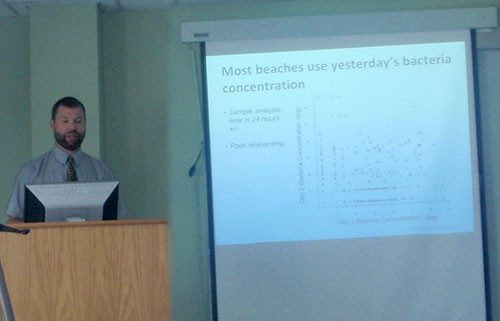Discussion following Heath Kelsey seminar on beach and shellfish forecasts using integrated data from monitoring programs, remote sensing, and observing systems
Bill Dennison · 
This blog post discusses the seminar given by Dr Heath Kelsey, of EcoCheck, at the IAN Seminar Series on April 22, 2010.
A wide ranging discussion of bacteria, viruses and contaminants in water and shellfish followed the seminar. Typical of discussions of bacteria in water or shellfish, the issue of the different methods was raised. The Most Probable Numbers technique used for faster turnaround (hours) was contrasted with the Membrane Filtration method which takes ca. 24 hours. In addition, there is a difference in the way regulatory agencies use data to instigate closures; beach closures are typically based on measurements (typically of the previous day or days) and shellfish closures are typically based on rainfall in the associated watershed. The other difference between beach and shellfish assessments is that enterococcus bacteria are assessed for beach closures and fecal coliform are assessed for shellfish closures. In both cases, these bacteria are used as indicators of water quality, and are not necessarily the pathogenic bacteria that would lead to human illness. Various other bacterial assessments include E. coli and vibrio, with technique development being actively pursued for various other bacteria. The holding time for water samples before testing is strictly limited to less than 6 hours and there are differences noted between different laboratories.

The importance of sediment resuspension in controlling bacterial abundance was discussed. Basically, anything that causes sediments to be resuspended into the water column can lead to spikes in bacteria concentrations. Natural events like wind mixing can occur, but also people swimming or boat propeller wash can cause sediments to be resuspended. Environmental factors like ultraviolet light and temperature also influence the life span of bacteria in the water column.
Heath talked about the idea of establishing a website that integrates a variety of relevant weather and water quality data for swimming beaches. This website could provide air temperature, water temperature, wind direction and velocity, ultraviolet light levels, sea nettle abundance and a prediction of bacterial levels. An important aspect to developing any beach predictions is to take into account the unique features at each beach. He joked that on days when the swimming beaches have high bacteria, the website could host ads for putt-putt golf and other non-swimming activities.
Heath pointed us to the national "Testing the Waters" website that ranks water quality at different swimming beaches by the National Resources Defense Council. On the NRDC ranking, the swimming beaches within Chesapeake Bay received good marks for posting advisories promptly both online and at the beaches, but poor marks for not testing water quality frequently.
About the author
Bill Dennison

Dr. Bill Dennison is a Professor of Marine Science and Vice President for Science Application at the University of Maryland Center for Environmental Science.

